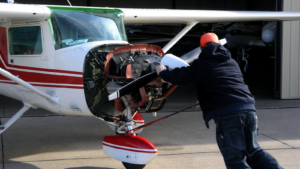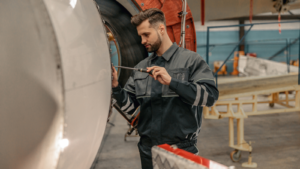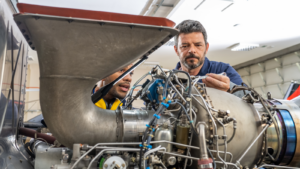As the wings of technology stretch wider, the world of aviation continues to soar to unprecedented heights. Yet, with these advancements come challenges, particularly in the realm of aviation repair solutions. This article delves into this critical aspect, exploring the latest trends, technologies, and techniques that are shaping the future of aircraft maintenance.
Aviation Repair Solutions
 Aviation repair solutions serve as pillars of safety and proficiency in the aviation industry. They support the balance between efficiency and safety, ensuring aircraft readiness for flight.
Aviation repair solutions serve as pillars of safety and proficiency in the aviation industry. They support the balance between efficiency and safety, ensuring aircraft readiness for flight.
Aviation repair solutions form a cornerstone of the industry. They maintain the functionality of aircraft, affecting everything from minor controls to large engines. Without these solutions, wear and tear would rapidly render aircrafts inoperable. For instance, without accurate and efficient engine repair procedures, the lifespan of an aircraft’s engine decreases significantly, impacting the overall operability of the fleet. Therefore, the industry relies on these solutions for fleet readiness and maintenance.
Impact on Flight Safety
Flight safety is paramount in the aviation industry. Aviation repair solutions directly influence this safety. Regular, detailed inspections and repairs can identify and resolve issues, such as microscopic fractures or mechanical faults before they pose a larger danger. For example, detecting and repairing a minor crack early on can prevent a catastrophic failure during a flight. Hence, aviation repair solutions significantly minimize risks and potential hazards, enhancing flight safety.
Technological Innovations in Aviation Repair Solutions
Technological innovations permeate and transform the domain of aviation repair solutions. This shift embraces forward-thinkers, elevating standards in precision, effectiveness, and safety.
Cutting-Edge Tools and Techniques
In an evolving industry such as aviation repair, cutting-edge tools and techniques become instrumental. Innovative, precision-based equipment like high-definition scanners and 3D printers significantly reduces manual labor, ensuring faster, error-free repairs. For instance, 3D printers fabricate parts on-demand, minimizing downtime during replacements. Similarly, high-definition scanning techniques facilitate a thorough, yet swift inspection of critical components, intercepting faults before they aggravate.
Role of Artificial Intelligence and Automation
 Artificial Intelligence (AI) and automation play a crucial role in reshaping the aviation repair landscape. AI collects and analyzes data, predicting potential issues in fixtures and mechanisms. For instance, AI-powered diagnostic tools scrutinize data patterns, warning ahead of possible breakdowns. Automation, on the other hand, streamlines repair processes. Automated systems, such as robotic arms, perform tasks with unwavering accuracy and consistency, lowering the probability of human error and enhancing overall efficiency.
Artificial Intelligence (AI) and automation play a crucial role in reshaping the aviation repair landscape. AI collects and analyzes data, predicting potential issues in fixtures and mechanisms. For instance, AI-powered diagnostic tools scrutinize data patterns, warning ahead of possible breakdowns. Automation, on the other hand, streamlines repair processes. Automated systems, such as robotic arms, perform tasks with unwavering accuracy and consistency, lowering the probability of human error and enhancing overall efficiency.
Prospects and Challenges in the Field of Aviation Repair
This section explores the potential opportunities and hurdles anticipated in the realm of aviation repair solutions.
Future Developments
Technological innovations continue to shape the trajectory of aviation repair. Advanced 3D imaging technology holds promise for enhancing inspection capabilities and pinpointing structural flaws more accurately. Moreover, augmented reality (AR) is emerging as a valuable tool for training maintenance crews, propelling efficiency and error reduction in repair tasks. Leveraging these technologies, companies can detect, analyze, and resolve issues sooner, thus boosting aircraft safety and performance.
Existing Obstacles
Notwithstanding the opportunities, challenges persist. High operational costs, primarily related to the acquisition of advanced technologies, impose a significant burden on aviation repair solutions. Stringent regulatory requirements also pose an obstacle, as meeting these norms requires constant updates and revisions in repair methods. Furthermore, the industry faces the challenge of equipping the workforce with the necessary skills to handle sophisticated technologies, necessitating intensive training and knowledge upgradation. These hurdles need immediate addressing to unlock the full potential of aviation repair.
Staying Ahead in Aviation Repair
 Aviation repair solutions are pivotal in maintaining aircraft functionality, ensuring flight safety, and extending the lifespan of aircraft components. They’re not just about fixing problems but also about preventing them, thanks to advancements in technology like AI and automation. High-quality repairs carried out by experienced professionals can help keep costs manageable by preventing severe issues and costly overhauls. Yet, the industry faces challenges such as high operational costs and stringent regulatory requirements, which need addressing to fully unlock the potential of aviation repair solutions. In this ever-evolving field, staying abreast of the latest trends, technologies, and techniques is key to ensuring long-term success and safety in the aviation industry.
Aviation repair solutions are pivotal in maintaining aircraft functionality, ensuring flight safety, and extending the lifespan of aircraft components. They’re not just about fixing problems but also about preventing them, thanks to advancements in technology like AI and automation. High-quality repairs carried out by experienced professionals can help keep costs manageable by preventing severe issues and costly overhauls. Yet, the industry faces challenges such as high operational costs and stringent regulatory requirements, which need addressing to fully unlock the potential of aviation repair solutions. In this ever-evolving field, staying abreast of the latest trends, technologies, and techniques is key to ensuring long-term success and safety in the aviation industry.



